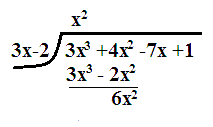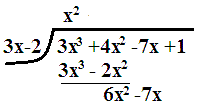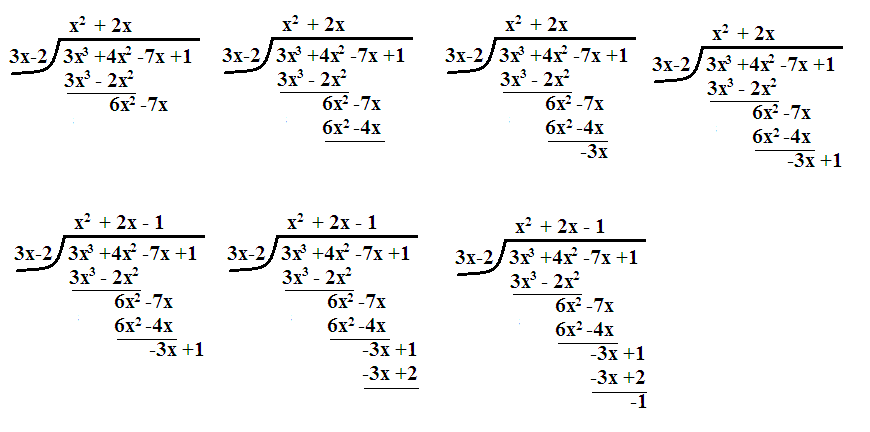We use a slightly modified table when the coefficient of #x# does not equal #1#. Note the extra lines.
Step 1. Write only the coefficients of #x# in the dividend inside an upside-down division symbol.
#|3" "4" "-7" " " " "1#
#|color(white)(1)#
#stackrel("——————————————)#
Step 2. Put the divisor at the left.
#" "" "|3" "4" "-7" " " " "1#
#" "color(red)(2)color(white)(1)|#
#" "stackrel("——————————————)#
Step 3. Write the coefficient of #x# below the division line
#" "" "|3" "4" "-7" " " " "1#
#" "2|" "color(white)(1)2 " "" "4" "-2#
#" "stackrel("——————————————)#
#" "color(white)(1)|#
#color(red)(/3)color(white)(1)|#
Step 4. Drop the first coefficient of the dividend below the division symbol.
#" "" "|3" "4" "-7" " " " "1#
#" "2|" "color(white)(1)2 " "" "4" "-2#
#" "stackrel("——————————————)#
#" "color(white)(1)|color(red)(3)#
#/3color(white)(1)|#
Step 5. Divide the dropped value by the coefficient of #x# and place the result in the row below.
#" "" "|3" "4" "-7" " " " "1#
#" "2|" "color(white)(1)2 " "" "4" "-2#
#" "stackrel("——————————————)#
#" "" "|3#
#/3color(white)(1)|color(red)(1)#
Step 6. Multiply the result by the constant, and put the product in the next column.
#" "" "|3" "4" "-7" " " " "1#
#" "2|" "color(white)(1)color(red)(2)#
#" "stackrel("——————————————)#
#" "" "|3#
#/3color(white)(1)|1#
Step 7. Add down the column.
#" "" "|3" "4" "-7" " " " "1#
#" "2|" "color(white)(1)2#
#" "stackrel("——————————————)#
#" "" "|3" "color(red)(6)#
#/3color(white)(1)|1#
Step 8. Repeat Steps 5, 6, and 7 until you can go no farther.
#" "" "|3" "4" "-7" " " " "1#
#" "2|" "color(white)(1)2 " "" "4" "-2#
#" "stackrel("——————————————)#
#" "" "|3" "6" "-3" "color(red)(-1)#
#/3color(white)(1)|1" "2" "-1#
#(3x^3 +4x^2-7x+6)/(3x-2) = x^2+2x-1-1/(3x-2)#
Check:
#(3x-2)( x^2+2x-1-1/(3x-2)) = (3x-2)(x^2+2x-1)-1#
#= 3x^3+6x^2-3x-2x^2-4x+2-1 = 3x^3+4x^2-7x +1#







